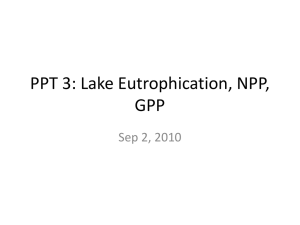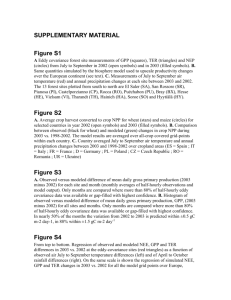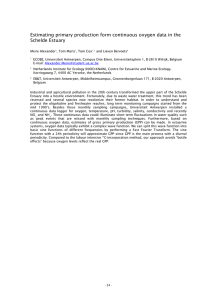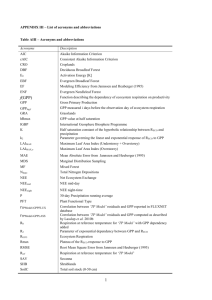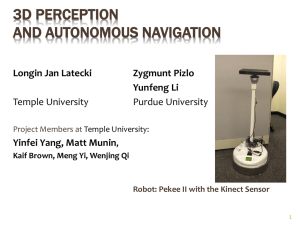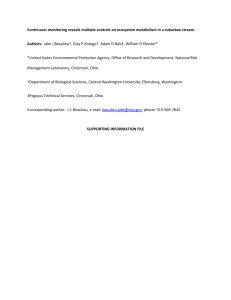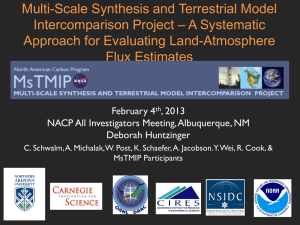Document 11842155
advertisement
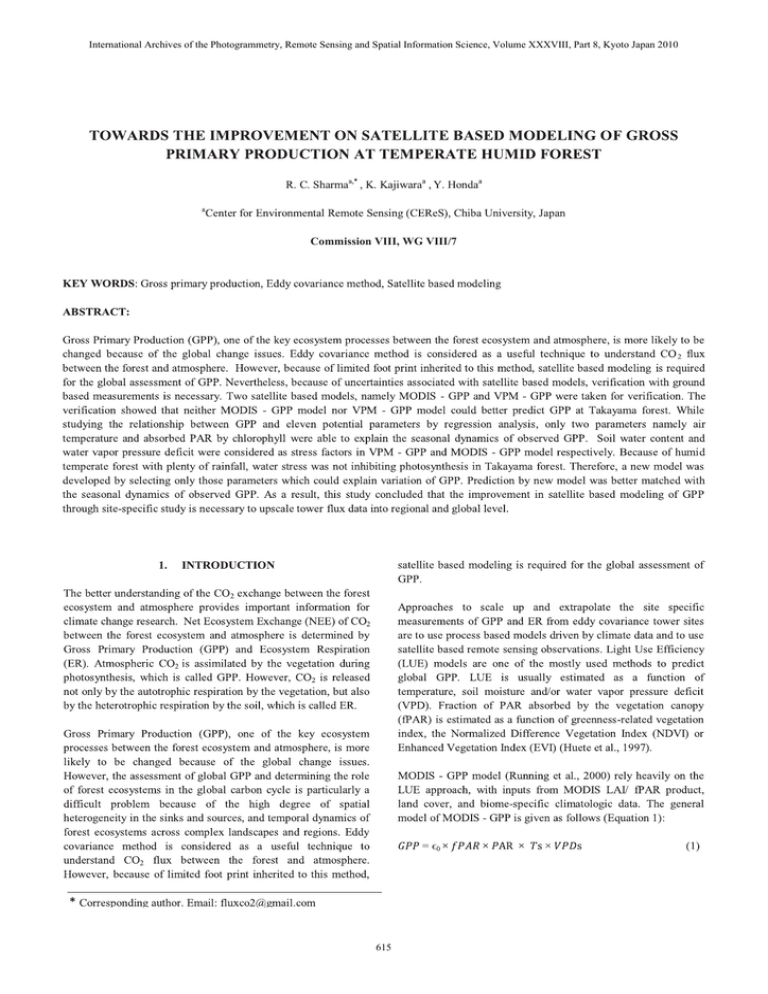
International Archives of the Photogrammetry, Remote Sensing and Spatial Information Science, Volume XXXVIII, Part 8, Kyoto Japan 2010 Commission VIII, WG VIII/7 615 International Archives of the Photogrammetry, Remote Sensing and Spatial Information Science, Volume XXXVIII, Part 8, Kyoto Japan 2010 Where, ϵ0 = Maximum LUE (0.13 - 0.27 g C/ mol PAR) depending on biomes Ts = Stress factor of temp. (0 to 1) VPD = Stress factor of water vapor pressure deficit (0 to 1) fPAR = Fraction of incident PAR absorbed by vegetation canopy (0 to 1) PAR = Incident photosynthetically active radiation 2.2 Instrumentation Two instruments namely the ultrasonic anemometer thermometer and infrared gas analyzer were used to measure the flux above the forest canopy (Fc). The lateral flux (Fs) was measured using infrared gas analyzer combined with inlet tube which were placed at 1.3 m, 2.0 m, 5.8 m, 8.8 m, 18.0 m, and 25 m above the ground level. The three-dimensional ultrasonic anemometer thermometer was used to measure the vertical wind velocity ten times per second. The Photosynthetically Active Radiation (PAR) having wavelength between 400 nm to 700 nm was measured by using the quantum sensor in terms of Photosynthetic Photon Flux Density (PPFD). Three components of PAR namely incident PAR, reflected PAR, and transmitted PAR were measured. Above the canopy at 20 m above the ground level, both the incident PAR and reflected PAR was measured. Below the canopy level, at 2 m above the ground level, the transmitted PAR was measured. Air temperature and relative humidity were measured at 10 m, 18 m, and 25 m above the ground level. Soil temperature was measured at 1 cm, 10 cm, 20 cm, and 50 cm below the ground level using platinum resistance thermometer. Similarly, soil water content was measured at 20 cm and 40 cm below the ground level. Other climatic variables including air pressure at 1.5 m above the ground level, and wind speed at 10 m and 25 m above the ground level were measured. Another LUE based model, the Vegetation Photosynthesis Model (VPM) (Xiao et al., 2004), use the Enhanced Vegetation Index (Huete et al., 1997), Land Surface Water Index (LSWI), air temperature and incident photosynthetically active radiation (PAR). The general equation of this model is given by (Equation 2): = ϵ0 × EVI × × s × (2) Where, ϵ0 = Maximum LUE (0.52 g C/mol PAR) for temperate broadleaf forest EVI = Enhanced Vegetation Index (0 to 1) PAR= Incident photosynthetically active radiation (mol/m2/day) Ts = Stress factor of temperature (0 to 1) LSWI = Land Surface Water Index (0 to 1) Although these LUE models have been used to estimate global or regional patterns of GPP, the LUE values on which they are based need to be calibrated rigorously because they greatly impact the accuracy of the model. Therefore, because of uncertainties associated with these satellite based models, verification with ground based flux measurement is necessary. 2. 2.3 Eddy covariance data The covariance between the vertical wind velocity and CO2 density was used to calculate Flux (Fc) for each half-hour period, which was later summed to get flux (Fc) for whole day. The lateral flux (Fs) was calculated for each hour period by integrating the change in CO2 density with respect to height (25 m). The absorbed PAR by canopy was calculated by subtracting reflected PAR and transmitted PAR from the total amount of incident PAR. Incident PAR having less than 10 µmol/m2/s was used to represent night period. The gaps in these independent variables were filled by averaging the data of the adjacent hours, days, and years of exactly the same time. However, the gaps in the flux (Fc) were not filled anymore. METHODS AND MEASUREMENTS 2.1 Study site The study site was about 15 km east of Takayama city, Gifu prefecture, in the central part of Japan (36˚ 08’N, 137˚ 25’’E; elevation 1420 m). The site is a mountainous, and a tower of 27 m in height is located on a ridge. Vegetation is an approximately 50-years old secondary broadleaf deciduous forest, primarily dominated by oak (Quercus crispula) and birch (Betula ermanii; Betula platyphylla var. japonica). The canopy height is about 15– 20 m. Trees has leaf area index of 3.5 m2/m2. The sub canopy is dominated by maple (Acer rufinerve; Acer distylum) and shrubs (Hydrangea paniculata; Viburnum furcatu). The understory is dominated by a dense evergreen dwarf bamboo (Sasa senanensis). The fetch length of this deciduous forest varies from 500 m to 1 km with wind direction. 2.4 Estimation of Gross Primary Production (GPP) The combination of Flux (Fc) and Flux (Fs) gives the NEE, which was separated into day period and night period. Both day period and night period NEE having less than 0.2 m/s friction velocity was rejected. Night time ER having less than 0.2 m/s friction velocity was gap filled using the temperature response function of night NEE. Then, day ER was calculated by using the same temperature response function of night period NEE. As a result, GPP was obtained by subtracting day period ER from the day period NEE. Using the temperature response function of day period GPP, the gaps in GPP were filled. Takayama forest is a cool - temperate deciduous broadleaf forest, which is a typical forest ecosystem in Japan. This forest was selected under this study to show how the satellite based models of GPP works in humid temperate forest in Asian environment. 616 International Archives of the Photogrammetry, Remote Sensing and Spatial Information Science, Volume XXXVIII, Part 8, Kyoto Japan 2010 2.5 Satellite data 3.2 Verification of MODIS-GPP model Eight days composite product of surface reflectance data (MCD43A4) recorded by MODerate Resolution Imaging Spectro Radiometer (MODIS) was obtained for the period of January 1, 2004 to December 31, 2005 from the Oak Ridge National Laboratory, Distributed Active Archive Center (ORNL, DAAC). This product was MODIS / Terra + Aqua Nadir BRDF - Adjusted Reflectance (NBAR), and had 500 m spatial resolution. The atmospheric and cloud correction was already applied by the ORNL, DAAC. Similarly, eight days composite product of GPP data was obtained from the ORNL, DAAC. Four spectral bands namely blue (450-520 nm), red (630-690 nm), near infrared (841–875 nm), and shortwave infrared (1628–1652 nm) were used to calculate different indices. Based on the geo-location information (latitude and longitude) of the flux tower site, surface reflectance data were obtained for 4 km2 area (4 by 4 pixels each having 500 by 500 m) locating the tower (36° 08’ 46.2’’ N and 137° 25’ 23.2’’E) at the middle of pixels. Similarly, the GPP product, which had 1 km spatial resolution, was obtained for 4 km2 (2 by 2 pixels) area. Finally, arithmetic mean from each pixel was calculated to represent Takayama forest for further calculations. Then the standard vegetation indices; namely Normalized Difference Vegetation Index (NDVI), Enhanced Vegetation Index (EVI), and Land Surface Water Index (LSWI) were calculated. The predicted GPP by MODIS team was compared with the observed GPP for the period of 2004 to 2005. MODIS-GPP estimation was 15.5 tC/ha/year. However, observation from eddy covariance method was 9.5 tC/ha/year. This shows that MODISGPP model over estimated GPP by 6 tC/ha/year. There were also differences in the seasonal dynamics between the observed GPP and predicted GPP (Figure 2). 3. 100 GPP (gC/m2/8days) 80 20 Jan Mar May Aug Oct Jan Mar Jun Aug Nov Jan Months during 2004 to 2005 Figure 2: Verification of GPP model provided by MODIS team 3.3 Verification of VPM - GPP model RESULTS AND DISCUSSIONS The predicted GPP by the VPM model was 7.0 tC/ha/year. This model underestimated the GPP by 2.5 tC/ha/year. However, the prediction by this VPM model was better than the prediction by MODIS-GPP model (Figure 3). 100 Observed GPP (gC/m2/8days) 80 GPP (gC/m2/8days) NEE / ER/ GPP (gC/m2/day) 40 -20 Three ecosystem components, namely GPP, ER, and NEE were estimated. They showed a distinct seasonal variation (Figure 1). GPP values were near zero in winter season (December, January, and February) because the deciduous leaves dominated canopy was bare and there was also low air temperature and frozen soil, which inhibited photosynthetic activities. GPP began to increase in late March and reached its peak in late June to early July. Then, GPP started to decline rapidly after its peak. 5 60 0 3.1 Seasonal dynamics of ecosystem components 10 MODIS predicted GPP (gC/m2/8days) Observed GPP (gC/m2/8days) NEE (gC/m2/day) ER (gC/m2/day) GPP (gC/m2/day) VPM predicted GPP (gC/m2/8days) 60 40 20 0 0 Jan Mar May Aug Oct Jan Mar Jun Aug Nov Jan Jan Mar May Aug Oct Jan Mar Jun Aug Nov Jan -20 Months during 2004 to 2005 -5 Figure 3: Verification of VPM – GPP model -10 -15 3.4 Derivation of new model Months during 2004 to 2005 There was discrepancy between predicted GPP from the satellite based model and observed GPP from the tower flux data. Neither Figure 1: Seasonal variation of ecosystem components 617 International Archives of the Photogrammetry, Remote Sensing and Spatial Information Science, Volume XXXVIII, Part 8, Kyoto Japan 2010 MODIS-GPP nor VPM-GPP model could better predict GPP at Takayama forest. Therefore, regression analysis was done to find out the good parameters of GPP. The regression coefficients between the observed GPP and its potential parameters have been summarized in Table 1. well predicted GPP as compared to other models. In addition, this model could better predict the seasonal dynamics of GPP. (Figure 4). 100 Table 1: Regression analysis between the potential parameters of GPP and the observed GPP 1 2 3 4 5 6 7 8 9 10 11 Potential parameters of GPP Incident photosynthetically active radiation (IPAR) Air temperature (T) Soil temperature (ST) Water vapor pressure deficit (VPD) Soil water content (SWC) Land surface water index (LSWI) Day length (DL) Enhanced vegetation index (EVI) Absorbed PAR by canopy (APAR) Absorbed PAR by chlorophyll contents (APARchl) Atmospheric CO2 concentration (CO2) 80 GPP (gC/m2/8days) S.N. R2 with observed GPP R2 = 0.15 R2 = 0.81 R2 = 0.77 R2 = 0.09 R2 = 0.35 R2 = 0.0009 R2 = 0.41 R2 = 0.85 R2 = 0.58 R2 = 0.87 60 40 20 0 Jan Mar May Aug Oct Jan Mar Jun Aug Nov Jan -20 Months during 2004 to 2005 Figure 4: Verification of new model 4. CONCLUSION At Takayama forest, neither soil water content nor vapor pressure deficit could explain the variation of GPP. These parameters were considered as stress factors in satellite based models. Because of humid temperate forest with plenty of rainfall, water stress was not inhibiting photosynthesis in Takayama forest. Moreover, because of the forest located at hills and valleys, water vapor pressure deficit could not explain the variation in GPP. Therefore, current satellite based models could not well predict GPP at this humid temperate forest. Therefore, a new model was developed by selecting only those parameters which showed a strong coefficient of determination with observed GPP. Prediction by this new model was better matched with the seasonal dynamics of observed GPP. As a result, this study concluded that the improvement in satellite based modeling of GPP through site-specific study is necessary to upscale flux tower data into regional and global level. R2 = 0.26 While considering 11 parameters, only two parameters namely; air temperature (T), and absorbed PAR by chlorophyll contents (APARchl) could well explain the variation of GPP. So, a new model (Equation 3) was developed considering only those parameters which showed a good relationship with GPP, i.e., air temperature (T) and absorbed PAR by chlorophyll (APARchl). GPP = ϵ0 * APARchl * Ts Predicted GPP (gC/m2/8days) Observed GPP (gC/m2/8days) (3) Where, ϵ0 = Maximum light use efficiency observed at Takayama forest (5.6 gC/ mol APARchl) APARchl = Absorbed PAR by chlorophyll ATs = Stress by air temperature (fraction of 1.0) Unlike MODIS-GPP and VPM-GPP model, water as a stress in terms of water vapor pressure deficit (VPD) or land surface water index (LSWI) was not considered in a new model. In this new model, the PAR absorbed by chlorophyll (APARchl) is assumed as absorbed PAR by canopy (APAR) multiplied by Enhanced Vegetation Index (EVI) (Equation 4). REFERENCES APARchl = APAR * EVI Running, S.W., Thornton, P.E., Nemani, R., Glassy, J.M., 2000. Global terrestrial gross and net primary productivity from the earth observing system. In: Sala, O.E., Jackson, R.B., Mooney, H.A. (Eds.), Methods in Ecosystem Science. Springer-Verlag, New York, pp. 44–57. Huete, A. R., Liu, H. Q., Batchily, K., and vanLeeuwen, W., 1997. A comparison of vegetation indices over a global set of TM images for EOS-MODIS. Remote Sensing of Environment, 59, pp. 440– 451. (4) 3.5 Verification of new model at Takayama forest The observed GPP was compared with the predicted GPP by new model. The model predicted GPP was 10 tC/ha/year. This model 618 International Archives of the Photogrammetry, Remote Sensing and Spatial Information Science, Volume XXXVIII, Part 8, Kyoto Japan 2010 Xiao, X.M., Zhang, Q.Y., Braswell, B., Urbanski, S., Boles, S.,Wofsy,S., Moore, B., Ojima, D., 2004. Modeling gross primary production of temperate deciduous broadleaf forest using satellite images and climate data. Remote Sens. Environ. 91, pp. 256–270. 619
